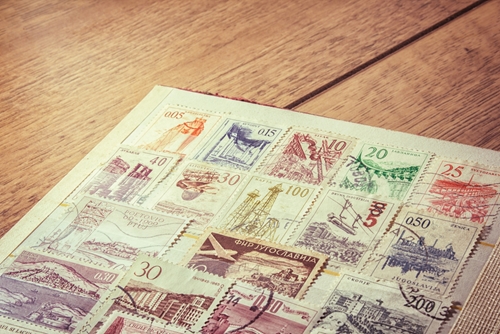So you’ve written a few business thank you cards or party invitations, you’ve stuffed and addressed the envelopes and now you have one last step before putting them in your outgoing mailbox: You have to stamp them. Postage stamps are often an afterthought – I know I never really think about them when I’m sending mail. But in truth, postage stamps have a pretty interesting history, and they’re actually directly related to the huge popularity of birthday cards, Christmas cards and all other greeting cards. Here’s a brief history of stamps:
The first stamp
The first postage stamp ever was created as a solution to a very big problem in England. Before stamps were created, a system was in place that required the recipient (not the sender) of any letters or notes to pay for them. As the prices were often very high because of the many taxes and tariffs charged for the postal service, often the recipients simply refused to pay. On top of that, because of the high charges for sending letters, people had begun to trick the post office by writing messages in code on the outside of the letter – that way, the recipient of the note could simply look at the piece of paper, read the coded message then refuse to pay the postal worker.
That’s why, in the 1830s, a man named Rowland Hill came up with a way for the sender to pay: the postage stamp. He worked with Britain’s Postmaster General Lord Lichfield, and the two came up with an idea that would abolish tariffs and charge a single penny for people to send letters. They decided to use an adhesive label to prove the sender had paid for the postage. In 1839, Hill held a contest for the design of the first postage stamp. The winning design was an intricate portrait of Queen Victoria on a black background. That first stamp from 1840 is known as the “penny black.”
From then to now
In the first year after the postal service was reformed and stamps were introduced, the British sent 70 million letters. Over the next several years, other countries began implementing the postage stamp system. The second country to use official stamps was Brazil, followed by Zurich and Geneve. The first official stamps in the United States were designed in 1837 and depicted Benjamin Franklin and George Washington.
Nowadays, stamps are ubiquitous across the globe, and they’re much pricier than a single penny, or even 5 or 10 cents. Greeting cards are a multi-billion dollar a year industry, and stamps are how we’re able to send sympathy cards, graduation announcements and any other type of message to friends and family.
The most valuable stamps in the world
As stamps have grown in popularity, so has the practice of stamp collecting, or philately. Some stamps have become extremely valuable for collectors. Here are some of the most valuable stamps in the world:
- The Three Skilling Yellow: The Three Skilling Yellow stamp comes from Sweden, which created various stamps in 1855. The Three Skilling Yellow stamp was a mistake during printing, as the other stamps worth three skillings were greenish-blue. It’s not known how many yellow three skilling stamps were made from that mistake, but only one has been found.
- Penny Black: The Penny Black, the first stamp ever, is now extremely rare to find. In fact, the Penny Black is so rare, it was once bought for $5 million at an auction.
- Inverted Jenny: The Jenny stamp was the first made specifically for air delivery in 1918. A printing error caused one sheet of 100 stamps to be printed upside down, and these Inverted Jenny stamps are now extremely valuable.

